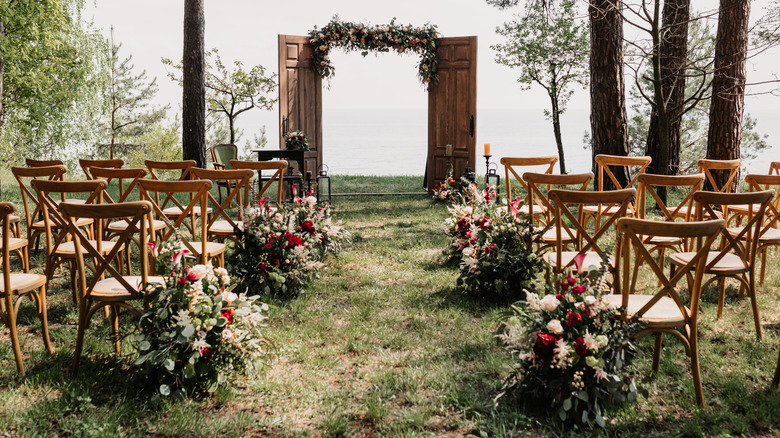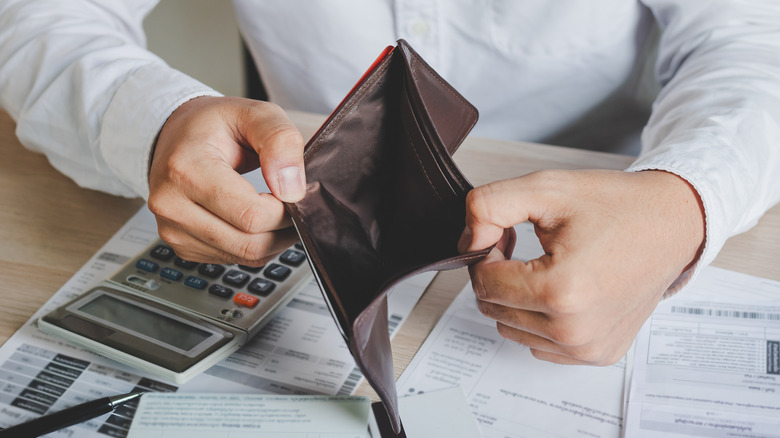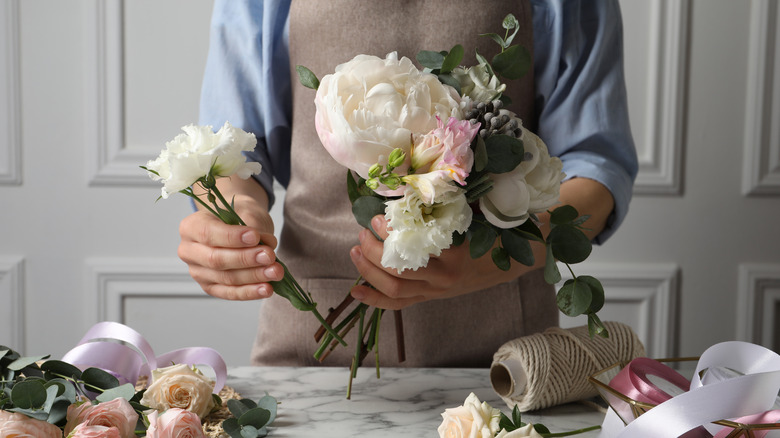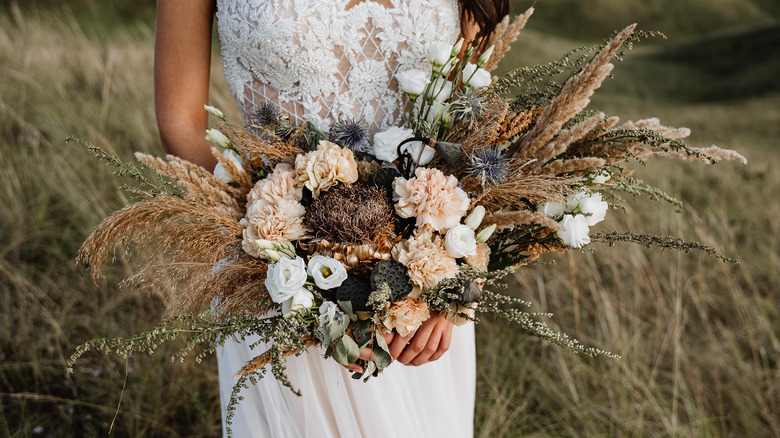Florists Reveal The Biggest Ways COVID-19 Changed The Wedding Industry - Exclusive
Everyone, and every industry, has been struggling with understanding how to navigate a world where COVID-19 has become the norm. While mask mandates and vaccine requirements have been dropped, many are still anticipating restrictions being put back in place if hospitalizations and deaths spike again.
This has meant a shift in the way plans are made and how businesses operate, sending a domino-effect of change through everything, including the wedding industry. In 2022, The Wedding Report says there is a 15% increase in the normal amount of weddings taking place, with over 2.5 million couples trying to tie the knot. Not only are there newly engaged couples, but there are still many who are trying to reschedule their big days from the past two years.
"It's a lot of pressure off of us to finally have money coming in again," Julie Kaplan of Emerald Invitations told NPR. Her small, family-owned business was just one of many impacted by the loss of income during pandemic shutdowns. "There were times we didn't think we were going to make it," she told NPR, admitting that she, like many others, had no backup plan.
But one of the biggest challenges Kaplan and other wedding vendors face is getting supplies. For florists especially, this has added new complications to services that are very high in demand.
Couples can expect to pay more for their weddings
Mandy Connor, owner of Boston's Hummingbird Weddings & Events, told NPR that not only is she doing more business than usual, but wedding planning has become so competitive that couples are being pressured to book vendors at their first meeting because otherwise, they could lose the space or DJ to the next couple the vendor meets with.
Aside from how hard it is to find vendors and spaces for weddings in 2022, if you do manage to snag a much-coveted date, you're likely going to be paying more for it. Connor told NPR that budgeting has become a guessing game; one client had a 30% increase in price between the estimate they were given at the time their contract was signed and when they received the final bill, Connor recalled.
While some price increases can be explained by labor costs and inflation, disruptions in the supply chain have caused major disruptions. "It's also impossible to get hold of some of the vital equipment required for weddings," Mary-Anne Da'Marzo, florist and founder of SoHo's The Last Bunch, told The List exclusively. Da'Marzo's shop specializes in dried and preserved flowers, and counts on being able to have easy access to things as simple as candles and vases. But even these have been difficult to get her hands on, she told us.
Of course, that doesn't take into account the major flower shortage that has also been plaguing the wedding and floral industry.
How florists are handling the flower shortage
Rishi Patel, chief executive and creative officer at HMR Designs, explained to The New York Times that, "Floral growers lost so much with all the wasted or unsold product from the worldwide shutdown in 2020," adding that growers "were apprehensive on how much to plan for 2021 and beyond." This has made many flowers, including popular wedding flowers like roses and carnations, almost impossible to get. White flowers especially are almost impossible to find.
According to Florists Supply, many flower farms had to lay off workers after some farms lost 90% of their business. Getting those workers back has been a major challenge, which — combined with changes in weather — have had major impacts on harvesting. Florists Supply reports their partners in Ecuador and Colombia have experienced cold nights and wetter growing seasons, which has impacted rose growth in the region.
When florists do get flowers in, like with everything else in the wedding industry right now, the price has drastically gone up. One florist told The New York Times that for both domestic and imported flowers, when they used to pay $1.50 a stem for flowers, now they are paying at least $3 per stem more. The prices for white flowers specifically have risen 25 to 50%, per The New York Times.
With rising prices and low stock, florists and couples have both had to get creative with their budget in order to ensure everyone's wedding day is perfect.
Couples are kicking these wedding traditions, according to florists
Weddings in the time of COVID-19, despite cutbacks in restrictions, still look and feel different than we're used to. Kate Murtaugh, principal and creative director at Kate Murtaugh Events & Design, told Brides that she has seen the trends shift from generic events to weddings where every detail is carefully curated.
With micro-weddings, elopements, and the trend of backyard gatherings, Murtaugh explained that couples are able to create a "more unique and bespoke environments for guests," that can include custom food experiences, signature cocktails, extravagant flower installations, and other "immersive elements" that keep the focus of the day on the couple.
Clarissa Marchia, Founder of Boston's Lucy Blooms, told The List exclusively that venue and vendors aren't the only things couples have gotten flexible on. Backyard micro-weddings and elopements are taking place on any day of the week couples are able to secure what they want. Mary-Anne Da'Marzo, founder of The Last Bunch, told The List exclusively that she, too, has seen a rise in "mid-week" weddings since most wedding venues are booked out for years on the weekends.
"I think people just want to get married whenever a venue is available at this point!" Marchia added.
The best thing for couples planning on getting married in 2022 is to have patience and flexibility. If you have your heart set on specifics, waiting until the marriage rush has died down might be your best bet at getting everything you want.



